How to Run an International PPC Campaign: The Fullest Guide
You may have heard people describe international PPC as the key to nailing a global audience. But why are so many willing to bet on it?
There is one hard truth we have to admit. As much as we all hate ads, they’re effective – for both businesses and users who find what they need faster.
That’s why, even when it comes to conquering new markets far away, paid ads are a go-to strategy for many companies out there.
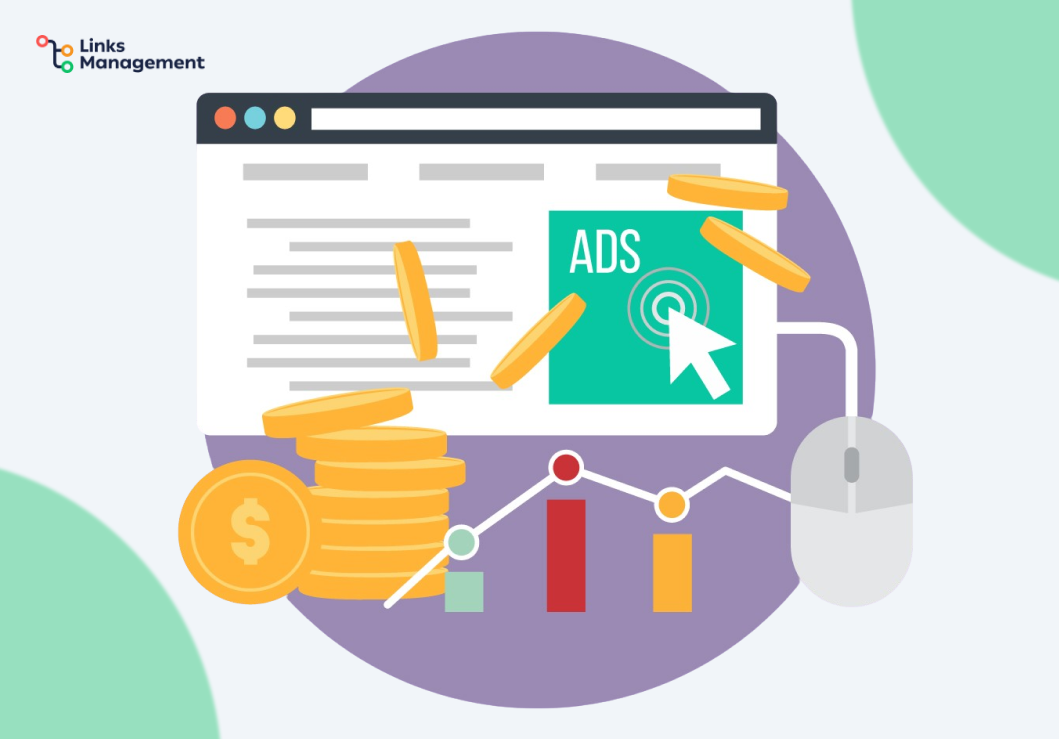
Yet, if you are new to PPC or this tactic has never worked that well for you, this guide is what you need.
Today, we will take a closer look at global paid advertising and figure out how to make it work. We will also explore what can stand in the way of your successful international ad campaigns.
Contents
- What Is Global PPC, and Who Needs It?
- International vs. Local Campaigns: Is There Any Difference?
- Things to Consider Before Working With International Paid Search
- 7 Steps to Run a Successful International PPC Campaign
- #1 Do Your Homework and Narrow Down Your Campaign Strategy to Match Each Target Audience
- #2 The Right Keywords Are Your Superpower
- #3 Plan Your Budget for Success
- #4 Create an Ad Copy That Gets a ‘Yes’
- #5 Get the Landing Pages Right, and You Have Won Half the Battle
- #6 Pick Up a Few PPC Tools
- #7 Get the Help From an International PPC Agency (If It Makes Sense for You)
- Conclusion
What Is Global PPC, and Who Needs It?
Global PPC (pay-per-click) means running online ads to attract an international audience – targeting different regions in various countries. These are the ads displayed at the top of search engine result pages (SERPs).
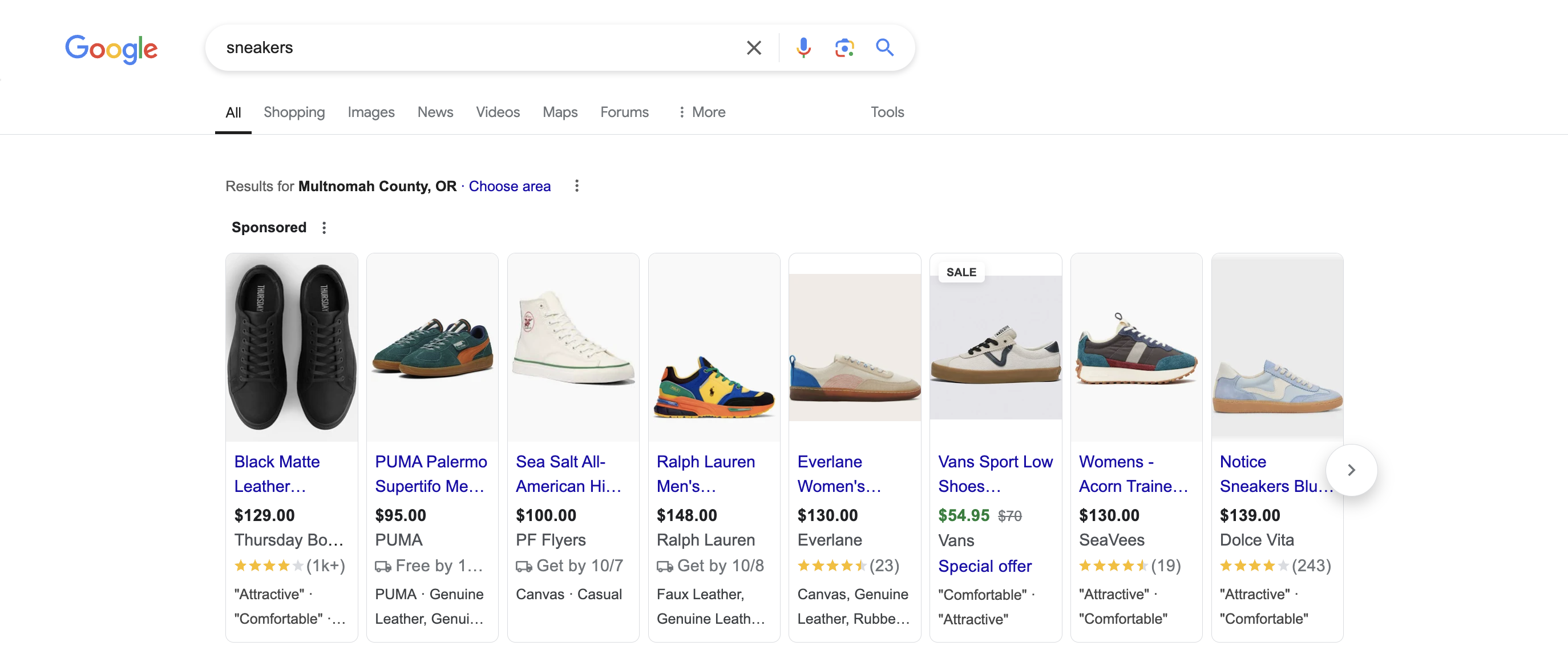
Source: Google
Since it lets you target specific keywords and pages with those phrases, you increase the chances of reaching people who actually need your product or services.
Plus, as the name suggests, when it comes to PPC, you only pay for clicks on your ads (not impressions), which makes it more cost-efficient.
No wonder international PPC is a very popular marketing tactic for:
- Advertisers who want to reach as many people as possible in several countries
- People who don’t want to drain their marketing budget
- Anyone looking to expand into new international markets
- Those who want quick results and don’t want to wait around for SEO
- Businesses who want to hyperfocus their marketing toward a very specific niche or demographic
- Marketers in niches where SEO can be quite tricky (e.g., gambling, casino, crypto, etc.).
International vs. Local Campaigns: Is There Any Difference?
Usually, a lot of newbie marketers assume that the difference between global and localized PPC is that the ads are not limited to just one location. But there is a lot more to it than that.
Different consumers from different countries will get to see a version of the ad that matches their location, depending on what keywords they use in their searches. So, since you are playing on the bigger stage, you will notice that:
- You need to adjust for context. When dealing with PPC worldwide, you will have to adjust your campaigns for many things, including the language, culture, currency, and habits – and that’s just the tip of the iceberg.
- You need to be more creative. Copy-pasting your local ads (and calling it a day) won’t work for an international audience. Everyone is different, and going for one-size-fits-all can only damage your brand reputation.
- The cost is lower compared to local PPC. Yes, you read that right. Because the US is so competitive, PPC costs are typically on the higher side. Flip it around, and you’ll find that competition tends to be lower in many markets outside the US.
Still, while the cost for a particular market may be lower, when you target several regions, the costs will add up, resulting in higher PPC budgets overall.
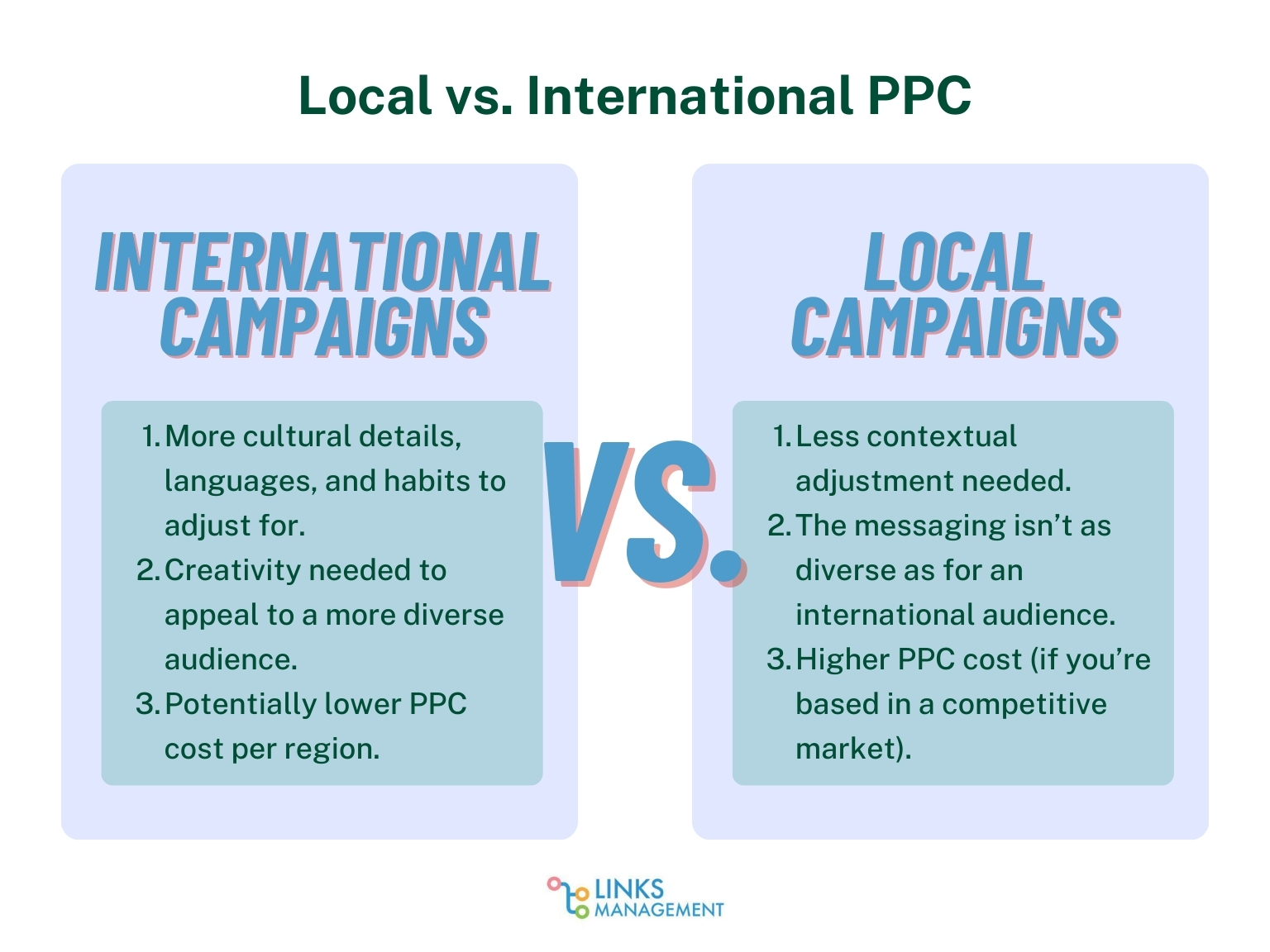
Things to Consider Before Working With International Paid Search
Sometimes, despite your best prep, you can still run into some hurdles. The most obvious ones are language and cultural barriers, but that’s not all. Here are some other struggles to keep in mind:
1️⃣ Issues With Payment and Currency Conversions
If you are running ad and marketing campaigns for an international audience, you need to support seamless payment in different currencies.
Yet, pulling this off is sometimes easier said than done, especially if the target region does not support many international payment platforms.
For example, some African countries can’t use PayPal, Chinese buyers are mostly using Alipay and WeChat Pay, and in some places, mobile money payments are more common than banks. So, all these can limit your options.
Another issue is that prices might not match in all countries. Even if you take a look at the giants, they adjust their subscription fees based on the location. For example, Netflix’s price can range from $2.82 to $21.48 per month, depending on the country.
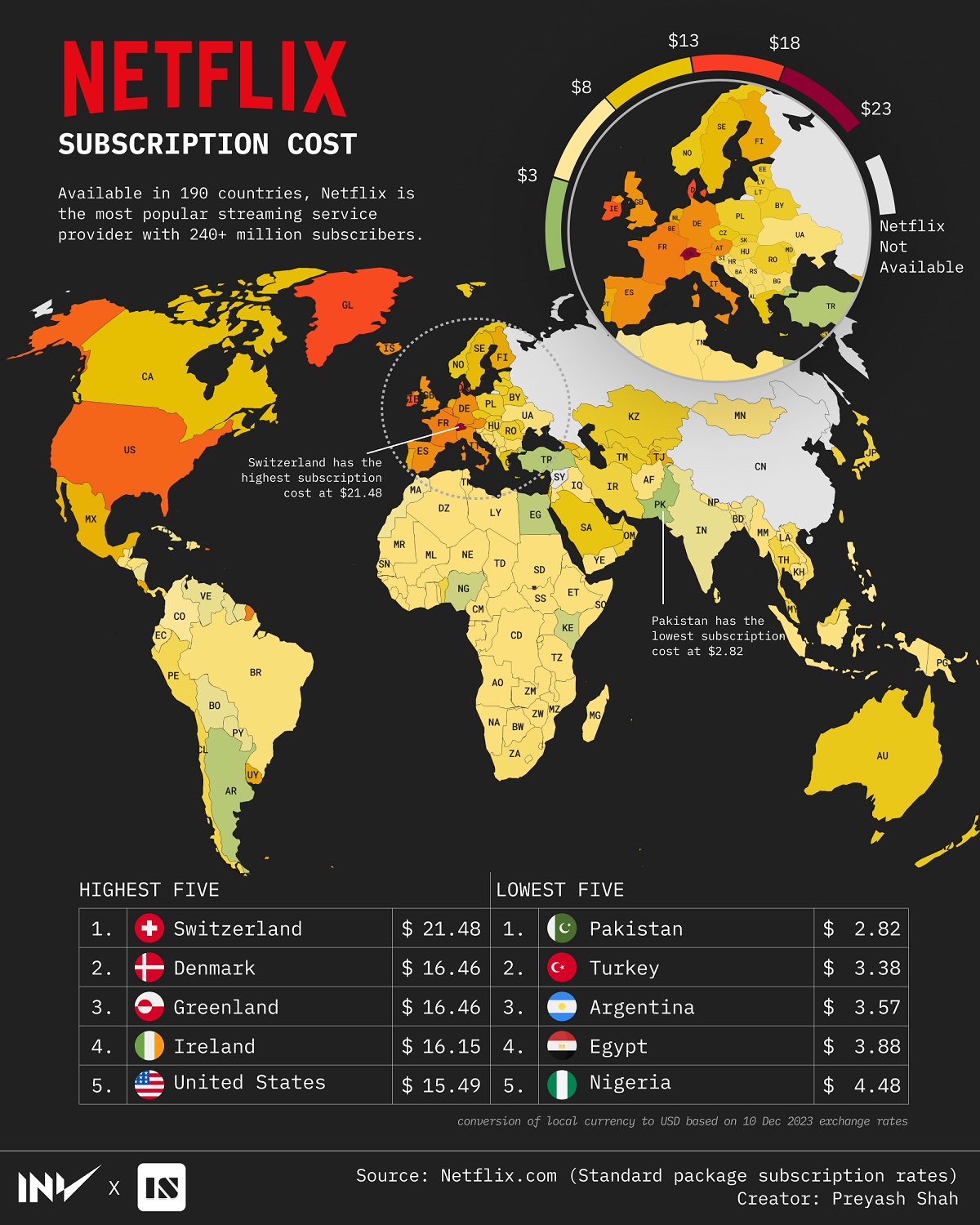
Source: Visual Capitalist
So, the price and payment methods are important things to consider if you hope to stand a chance in the foreign market.
2️⃣ Earning Trust
Trust is precious in the online marketing space, but it doesn’t come easily. It has to be earned. The trouble is – many people do not trust ads and would much rather go with the first organic result.
So, you have to build your social proof, get tons of reviews, create localized content, write guest posts, publish press releases, collaborate with local brands and bloggers, and buy white-hat backlinks to build your credibility.
All this will help you create a certain level of recognition in the new region. That’s why when people see your ad, they won’t feel hostile.
3️⃣ Unexpected Costs
Yep. If you want to really go all in and maybe even hire a multilingual PPC consultancy, you will quickly learn how much prices can change without warning, especially in foreign countries.
Even if you want to DIY most of it yourself, you might still need some sort of expert help at some point, a subscription to some SEO tools, unique localized posts, and other things that can increase your budget a lot.
7 Steps to Run a Successful International PPC Campaign
We have looked at many things that can affect international PPC campaigns, but now we have come to the meat of the issue – how to actually run it. This is where some people get stumped. But this won’t be you. Here are our top tried-and-true steps that work every time:
#1 Do Your Homework and Narrow Down Your Campaign Strategy to Match Each Target Audience
You can’t have a successful PPC ad campaign if you are not going to take enough time to do thorough market research first. That would be like trying to swim blindfolded in shark-infested waters.
You might make it to the other side, but you will probably lose something in the process.
To avoid throwing your marketing funds into the wind, it’s best to take the time to learn all you can about your new target market and country:
- Does your product or service align with any of your new audience’s needs or pain points at all – is it right for the market?
- Who are your customers, and what are they like? (It’s important to also know as much as you can about your target audience in each region.)
- What are the legal requirements and compliance laws for businesses like yours?
- What about the taxes?
You know how New York gives off a whole different vibe from Texas? Now, imagine this on a bigger scale. You have to understand the vibe and culture of each target region so you can tailor your international PPC campaign ads to resonate with people.
Create ideal customer profiles and buyer personas – this is a rough sketch of your typical customer (i.e., their age, gender, preferred medium for purchases, whether online shops, social media sales, walk-in stores, etc.).
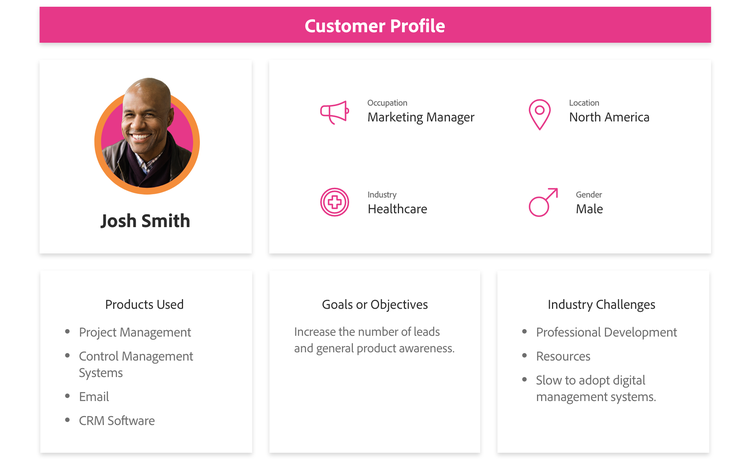
Source: Adobe
Knowing all these will help you avoid sending out generic ad campaigns that flop before they have even had a chance to shine. But how do you find your answers?
You could get experienced and credible international PPC services to do the groundwork for you so you can hit the ground running.
Alternatively, you could conduct surveys, read government reports (handy for knowing the legal terrain), look up other marketing studies done in that region, etc.
#2 The Right Keywords Are Your Superpower
There’s no guide explaining how to do a PPC campaign right that would skim over the importance of keywords. So, how do you get the right keywords for each region? Easy (relatively).
Use one of the SEO tools (Semrush, Ahrefs, etc.) to uncover your target keywords. In Semrush, for example, you can enter your keywords in the search box and pick the location to see useful metrics about that keyword in that region.
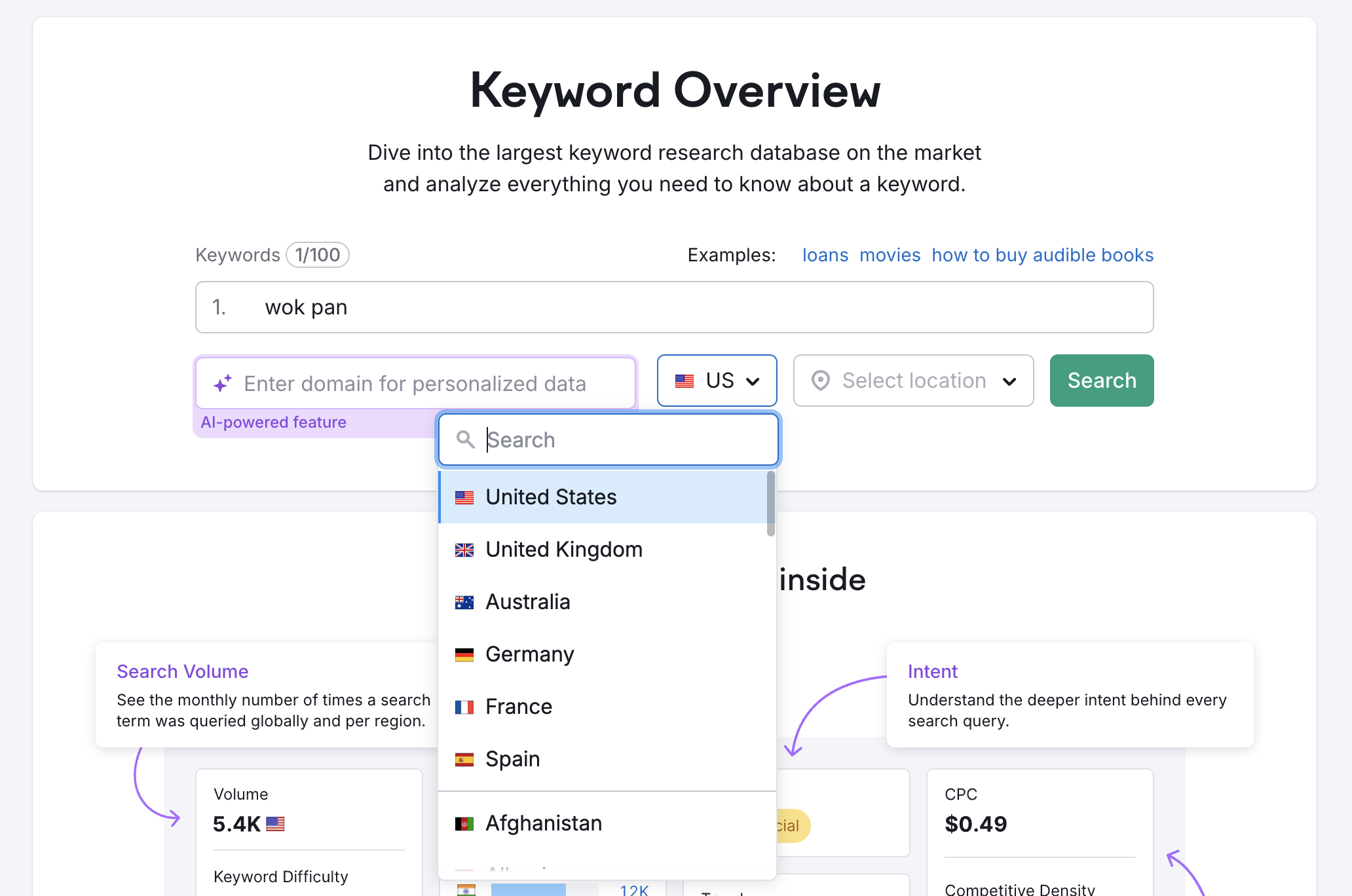
Source: Semrush
Remember that each keyword won’t translate well in every language. So, to improve your ads, follow these processes:
- Collect the main keywords and translate them into the target language using Google Translate or even ChatGPT.
- Keep in mind that these might not give perfect results, so if you can, ask someone to go over your keyword list and correct any errors.
- Now, check your translated keywords in your SEO tool. You probably won’t get too many with a promising monthly search volume, so no worries.
- If you’re still not sure, check your competitors’ blogs and landing pages for target keyword ideas (use Google Translate plugin if they have no English version). Add any suitable keyword to your list.
- Next, take your expanded list and poke around with Google Keyword Planner to find even more options.
- You’ll have to put everything in a spreadsheet, including the important metrics like search volume, keyword difficulty, and their translations (where needed). Then, select the relevant keywords for your search.
It might be tempting to throw the rest in the trash, but not so fast. At least not yet. Even negative keywords can come in handy in a pinch when there’s nothing else to use.
One last thing – Google may be the search giant in most parts of the world, but in some other places, it is the underdog. For example, in China, the main search engine is Baidu; in Russia, it’s Yandex, and so on.
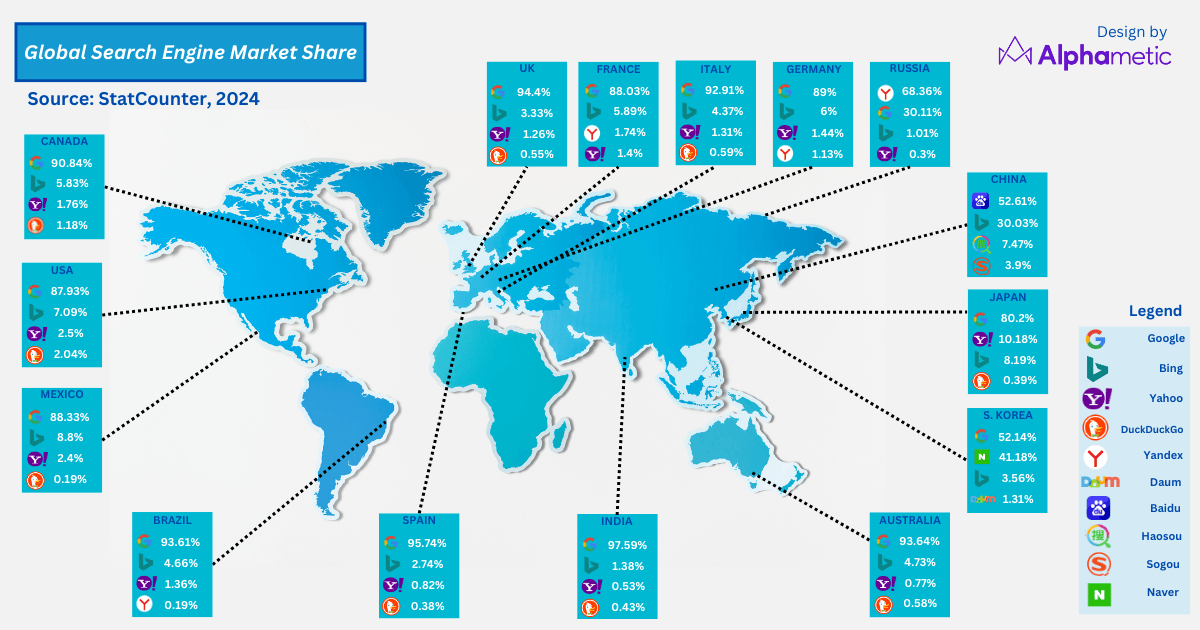
Source: Alphametic
So, take your time to study and fine-tune your keyword strategy for the dominant search engine in each country.
#3 Plan Your Budget for Success
Remember how we pointed out earlier that the challenge of multilingual PPC is that you are in an unfamiliar stage and will need more help as opposed to, say, local PPC? This is exactly why you need to figure out your budget as early as possible.
While PPC costs can be a lot lower outside the US, you might still end up spending a whole lot more if you are targeting several regions, especially if those are non-English speaking countries.
In some places, the dialect may be very different from one region to another, which means more work and resources if you want to advertise in more than one location. In addition to all these, your budget could increase if:
- You need human translators for each language
- Want to maximize the results and get as many clicks as possible
- Have a lot of keywords you are aiming for
- The target region has a digital tax (e.g., Australia and the UK)
Even if you get the budget right off the start, you need to be flexible. Anything can change, and if you tweak your PPC international campaigns or add certain keywords, you might need to spend a bit extra.
#4 Create an Ad Copy That Gets a ‘Yes’
Before we start getting into the details, think about your copy as your elevator pitch. Only yours will be limited to a fraction of a second (because most users simply scroll through all the ads without actually reading them). That’s why you have to give your best.
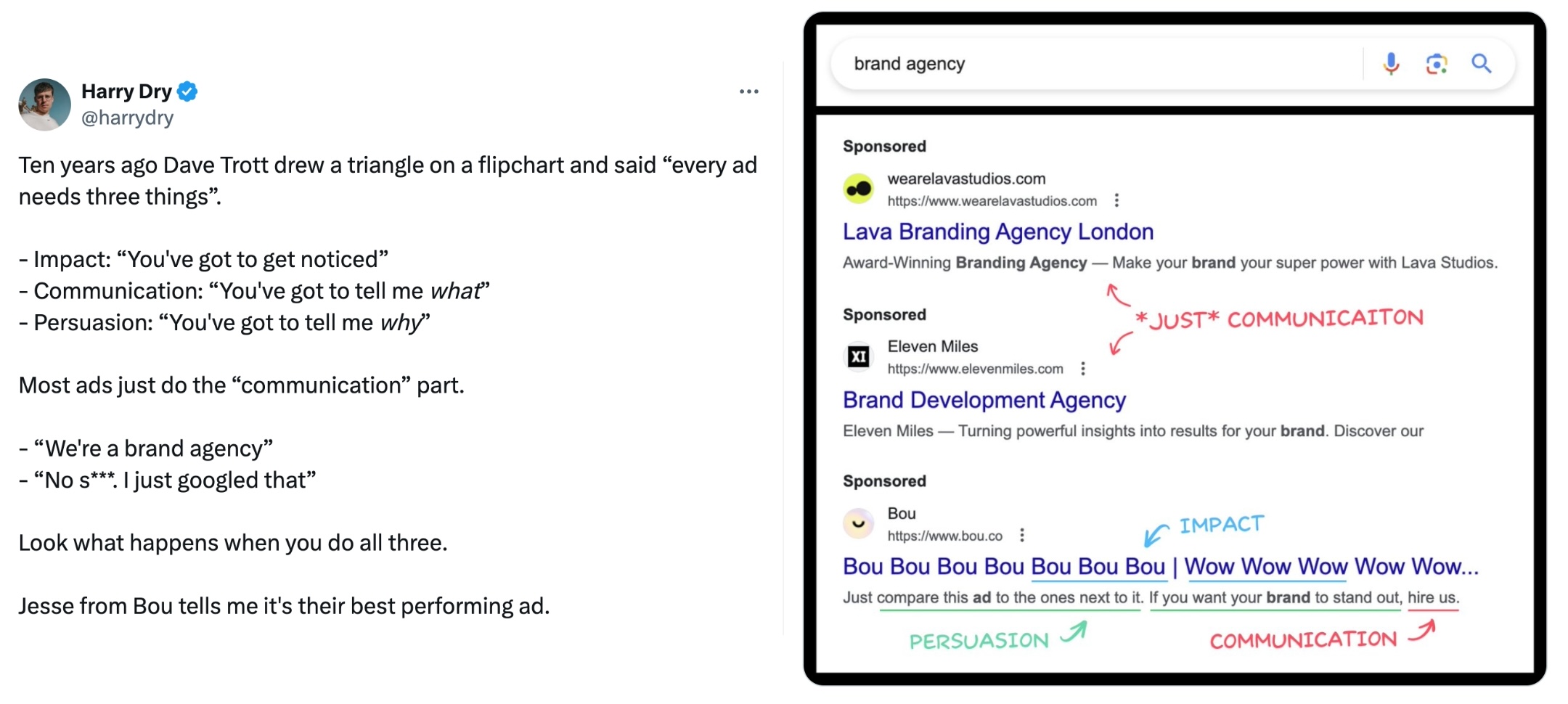
Source: @harrydry via X
Still, you have to understand the fundamentals of global PPC copy before writing your copy. Not sure how to start? You probably already know that the usual structure for a PPC ad is a headline, display text, and URL. Sure, now how do you write a great copy? Follow these steps:
- Get Inspired. You can take a few examples from your competitors. Then, show ChatGPT your current ad examples and your target keywords for them. Don’t take the exact copy ChatGPT comes up with, but play around and get some ideas on how to write your unique text.
- Create. In the creation process, you might introduce different keywords you’ve collected before and see which ones are a better fit.
- Edit. Next, you will need to then tweak each potential ad, adding relevant local lingos, currencies, etc. This way, your ad copy will really speak to your target consumers.
- Optimize. Keep the local cultural contexts in mind and adjust for them, especially if you go beyond Google Ads and work with visuals. For example, using red to signal passion in an ad would work in the US. But it might mean danger or political activism in other cultures. Being aware of these will help you get your ad copy right.
- Publish. Finally, publish your ads on popular PPC channels or platforms where your prospective consumers spend their time.
Pro tip: Since international PPC campaigns can look very different depending on your business and the market you plan to enter, you can try these tips:
- ✅ Start with one general campaign for the entire foreign country you want to target (if you have a sufficient budget). But don’t stop there.
- ✅ Analyze which regions perform better or worse. Once you have clear statistics, then go ahead and create separate campaigns for each foreign region that has performed well. This way, you can actually save your budget in the long run.
#5 Get the Landing Pages Right, and You Have Won Half the Battle
Here are the results you get when searching for “learn coding.”
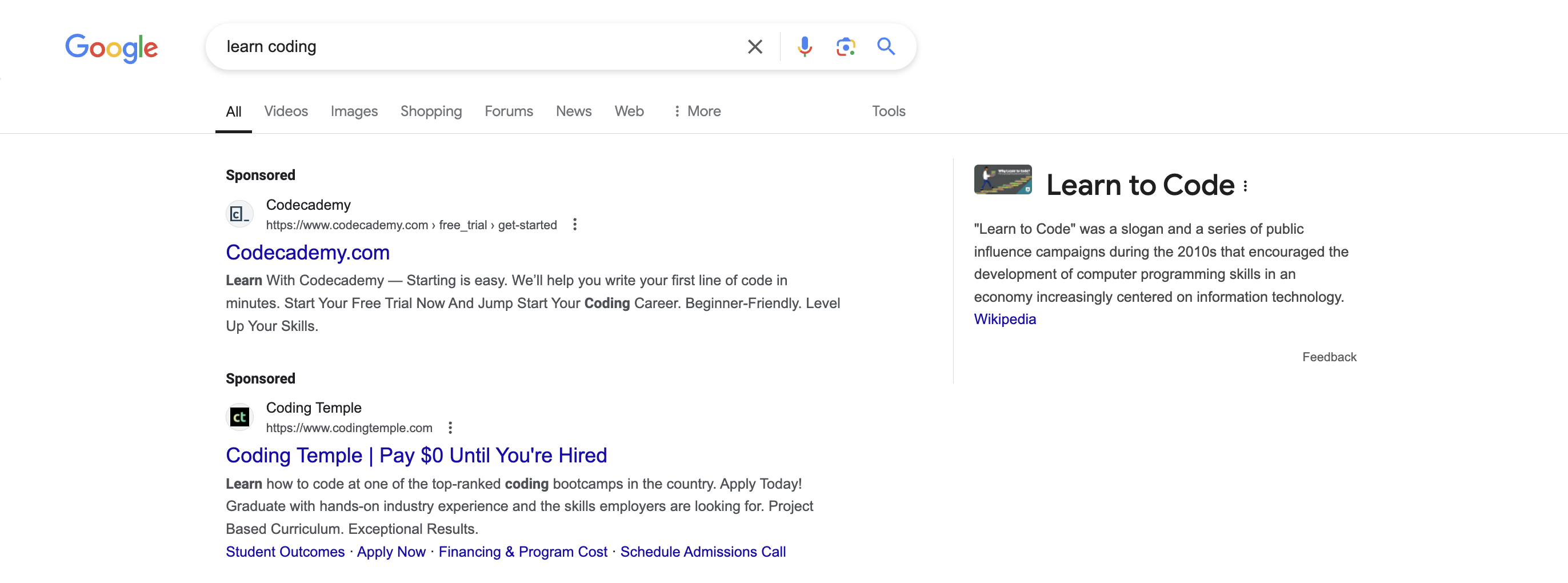
Source: Google
Now, clicking on the link in the first ad will lead you to the following page.
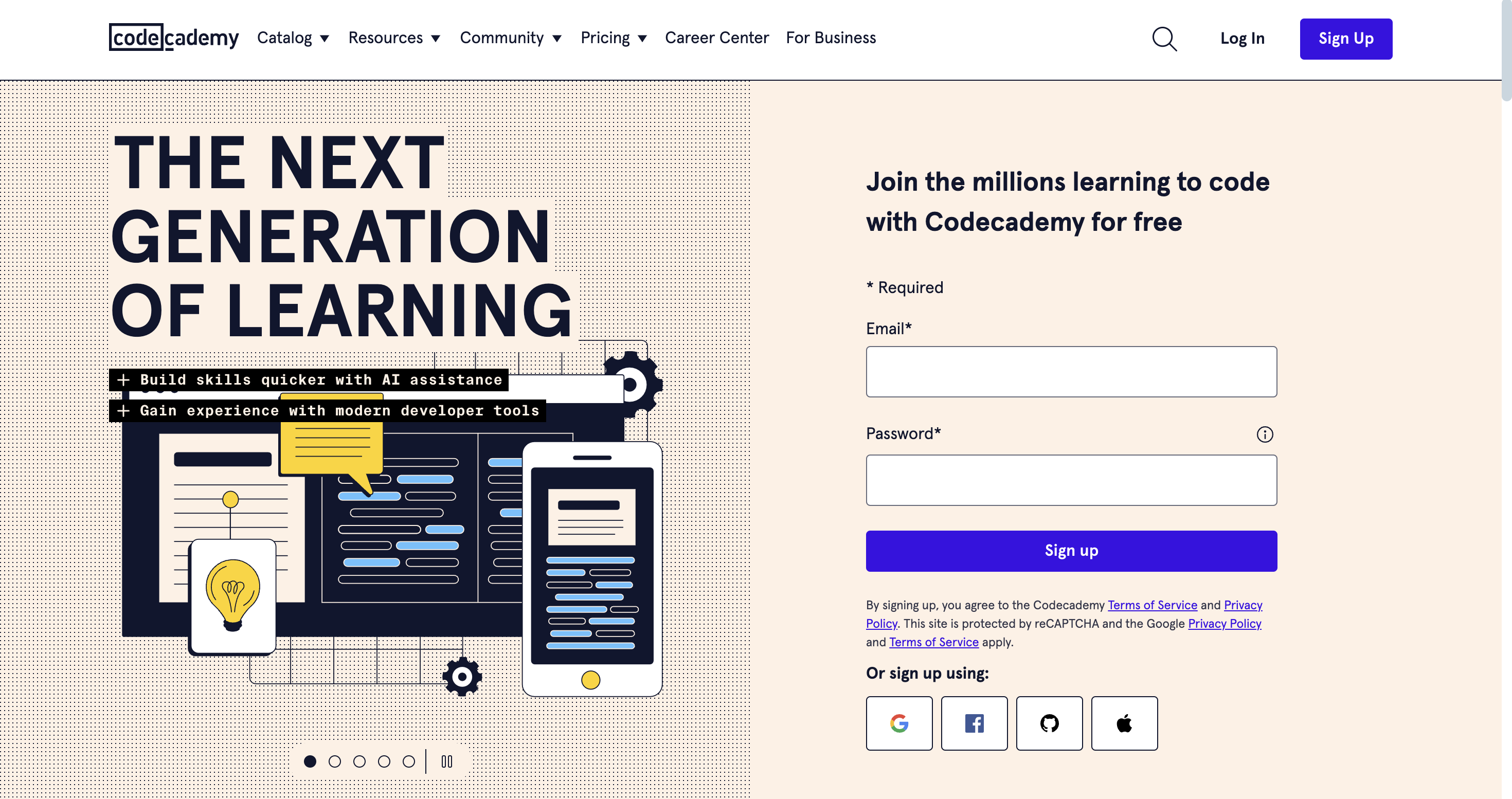
Source: Codecademy
Before you even create your ad copy, you should know exactly where you want people who click on your ad to land. This page is what’s called the landing page.
Some people direct all clicks to their homepage, but others build a special one for each ad campaign.
Codecademy decided to start with a sign-up form. While this is great to get more contacts on your email list, it isn’t the best strategy if your brand isn’t well-known.
To cater to different segments of the audience, they’ve added an interactive questionnaire in the next section that helps you find a course you need.
Of course, it isn’t a structure you have to follow, but it is a good idea to check your competitor’s landing pages and try to come up with a better version.

Source: Codecademy
Overall, when it comes to international PPC, make sure your landing page is properly optimized for each target region. Even something as simple as integrating the following aspects can make a world of difference:
- Multi-language support for each region (you might need a PPC translation team for this),
- Support in different timezones,
- Prices automatically converted to local currencies,
- Added support for local payment systems,
- Local shipping options,
- Maps or addresses to local stores if available.
Add branded visuals, a well-crafted compelling copy, a good contact form, and a concise, catchy CTA, and you are well-primed to rake in more conversions. Of course, each landing page must align with your ad copy. Want to increase your odds further?
Use local domain extensions. Customers from Spain might feel safer clicking on .es domains, and those in the US might be suspicious of websites ending in .ir, .in, and so on.
So, to help your customers from each region enjoy a more personalized experience, use a local domain extension and a well-translated copy.
For example, here is the international version of the Shopify website with the .com extension.
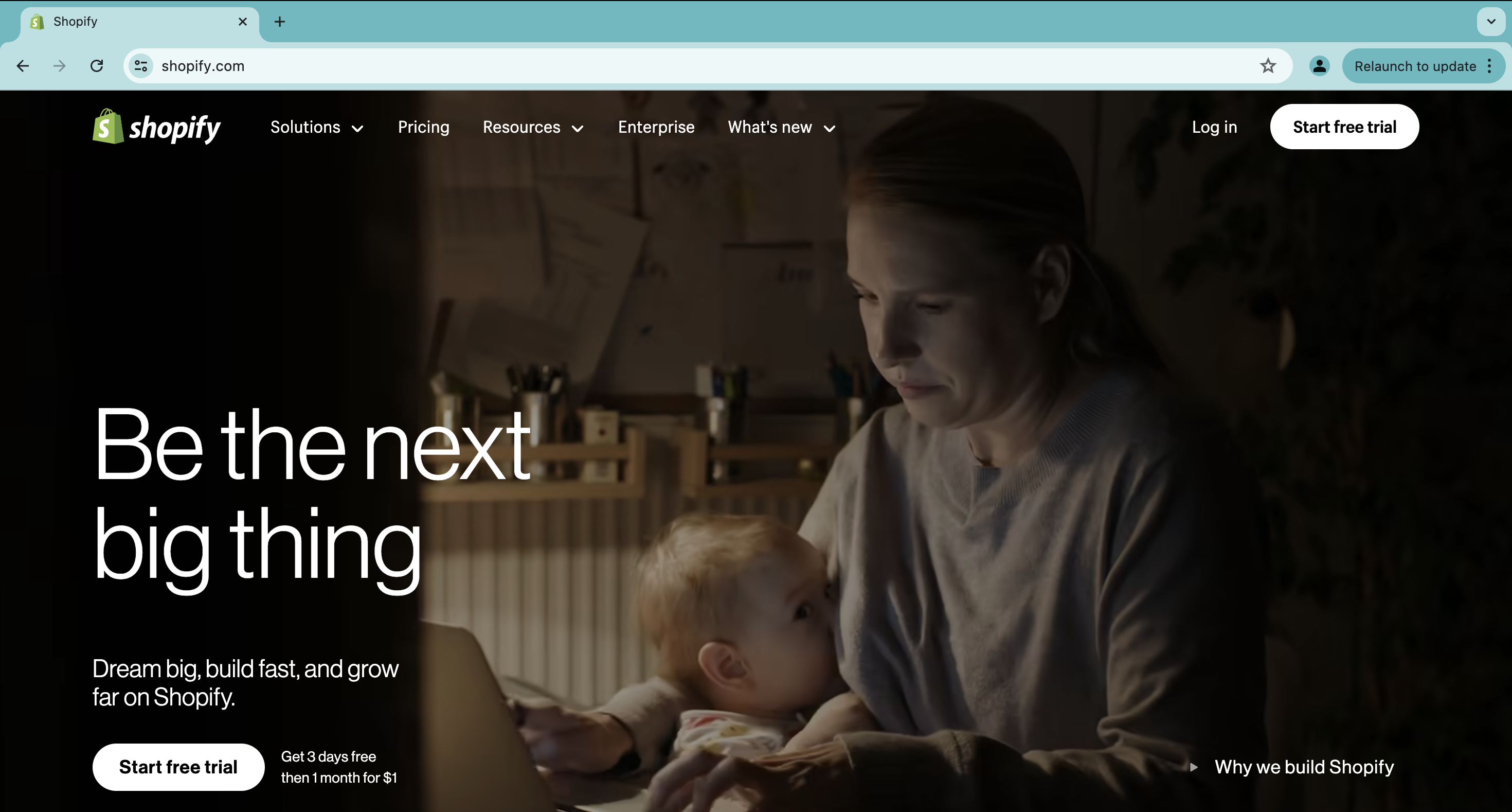
Source: Shopify.com
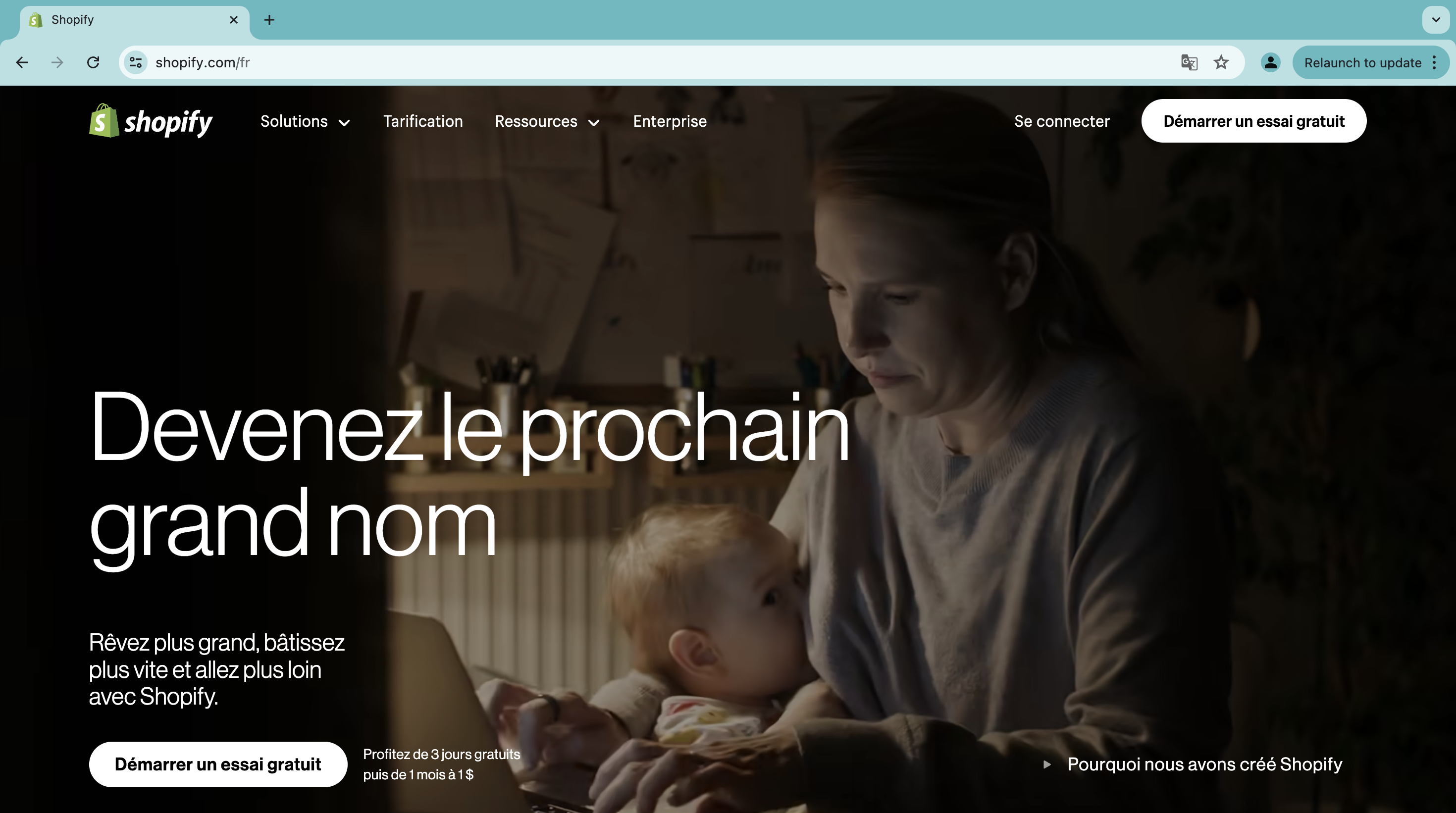
Source: Shopify.com/fr
One more thing — make it very easy for your visitors to convert. Remove unnecessary distractions like a form that is not needed, that weird pop-up ad that has nothing to do with the product you are advertising, etc.
Besides, you can always A/B test different sections, titles, messages, etc. It is very important to test the waters, especially if you’re entering a new market.
#6 Pick Up a Few PPC Tools
You are probably wondering, at this point – What else do I need to know how to run a PPC campaign successfully? There is one more essential thing we have not mentioned so far, and that’s tools.
The right international PPC management tool can make your work a lot easier and speed up your results. Plus, you can use it to manage your campaigns and even track your ad performance and keyword ranking.
Some of the most popular tools include:
- Google Ads platform. This is the obvious one. That’s why you have to understand how Google Ads works. Luckily, it won’t be hard, taking into account how many video tutorials you can find.
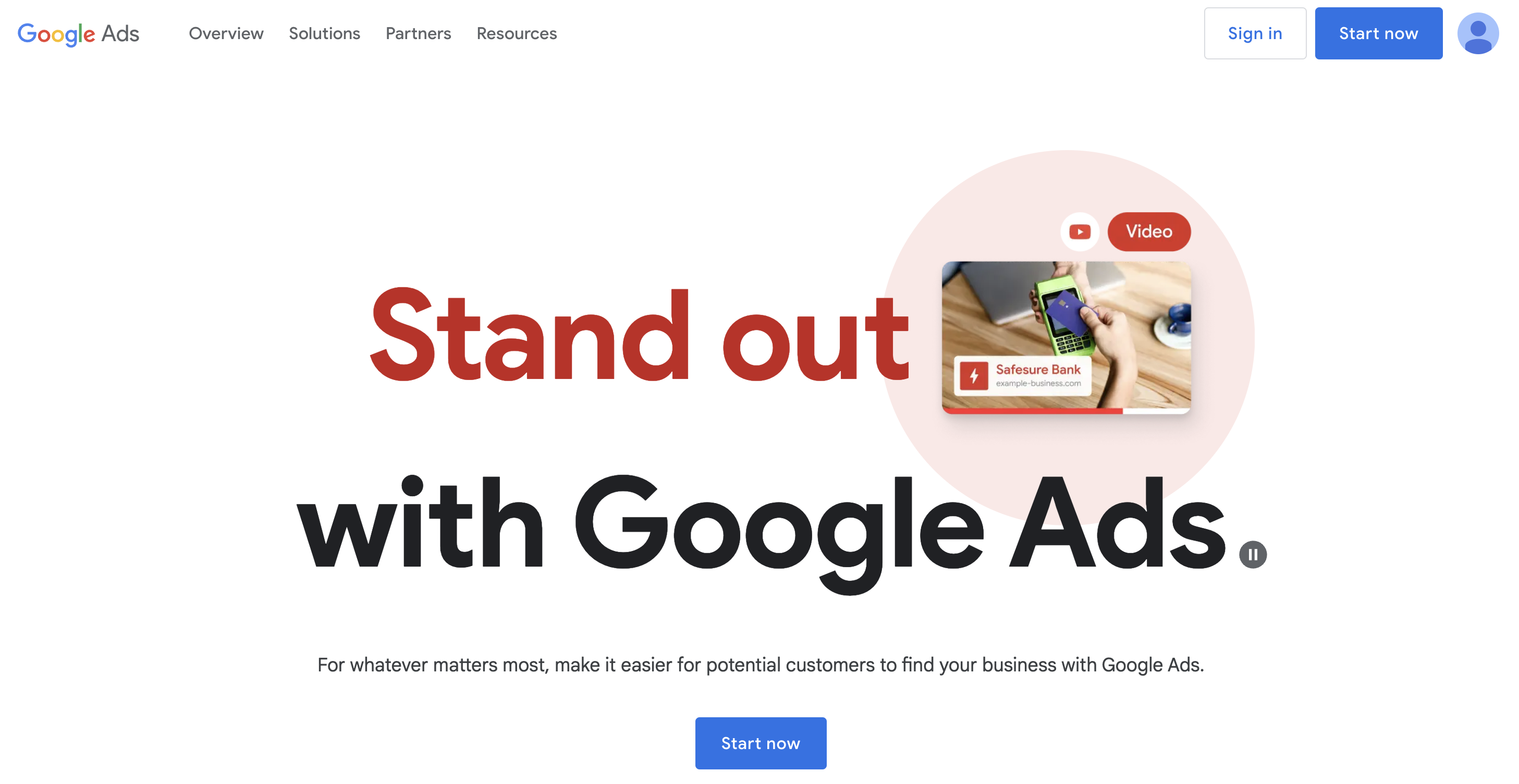
Source: Google Ads
- Meta Ads. The Meta Ads Manager has easy integration with Instagram and Facebook, which makes it easy to launch and manage your personalized social media ads across platforms.
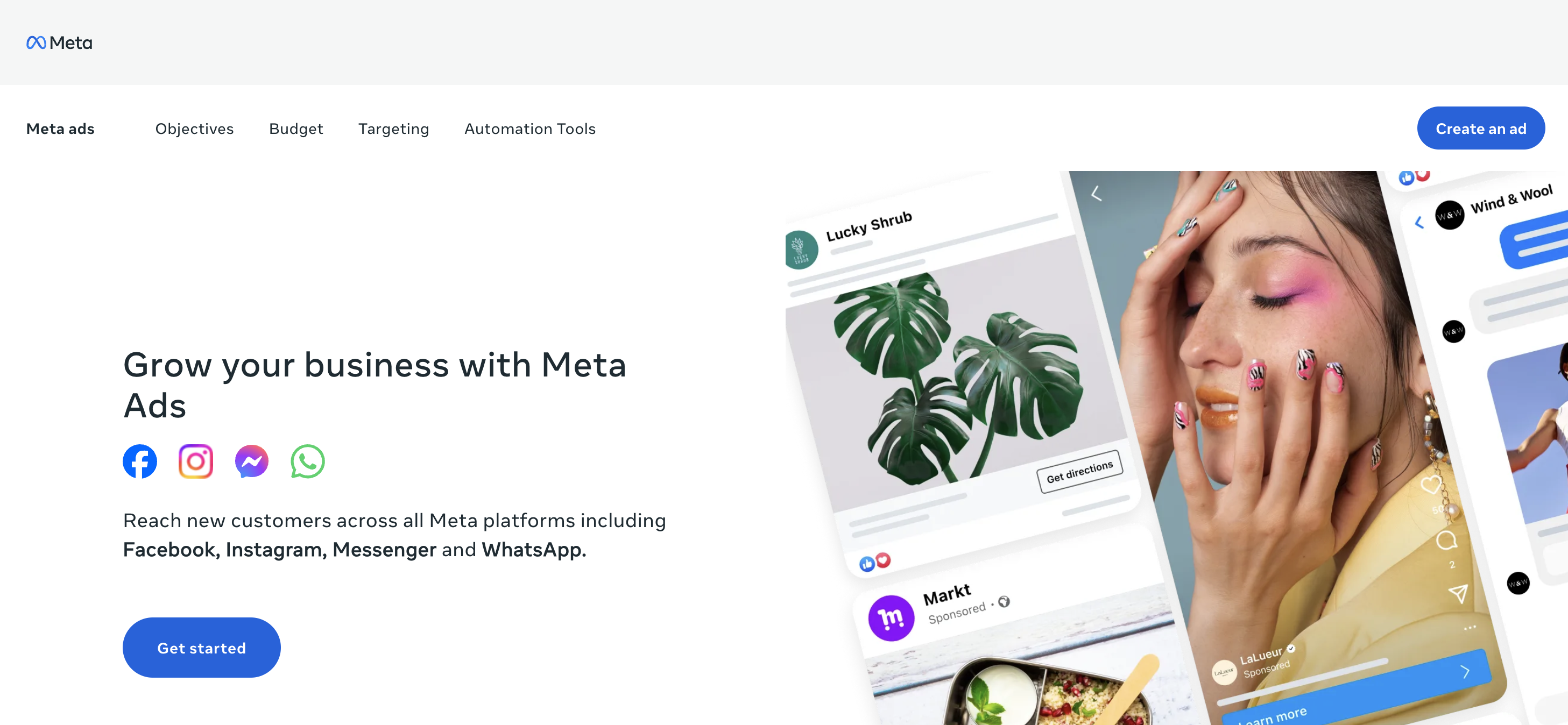
Source: Meta Ads
- Semrush PPC tools. Semrush has a whole set of tools that can be used for every stage of your Google PPC campaigns, from keyword research and setup strategies to managing ads.

Source: Semrush
- AdEspresso. This tool can be used to build and optimize campaigns for Google Ads. Plus, it allows split testing and supports both Facebook and Instagram ads.
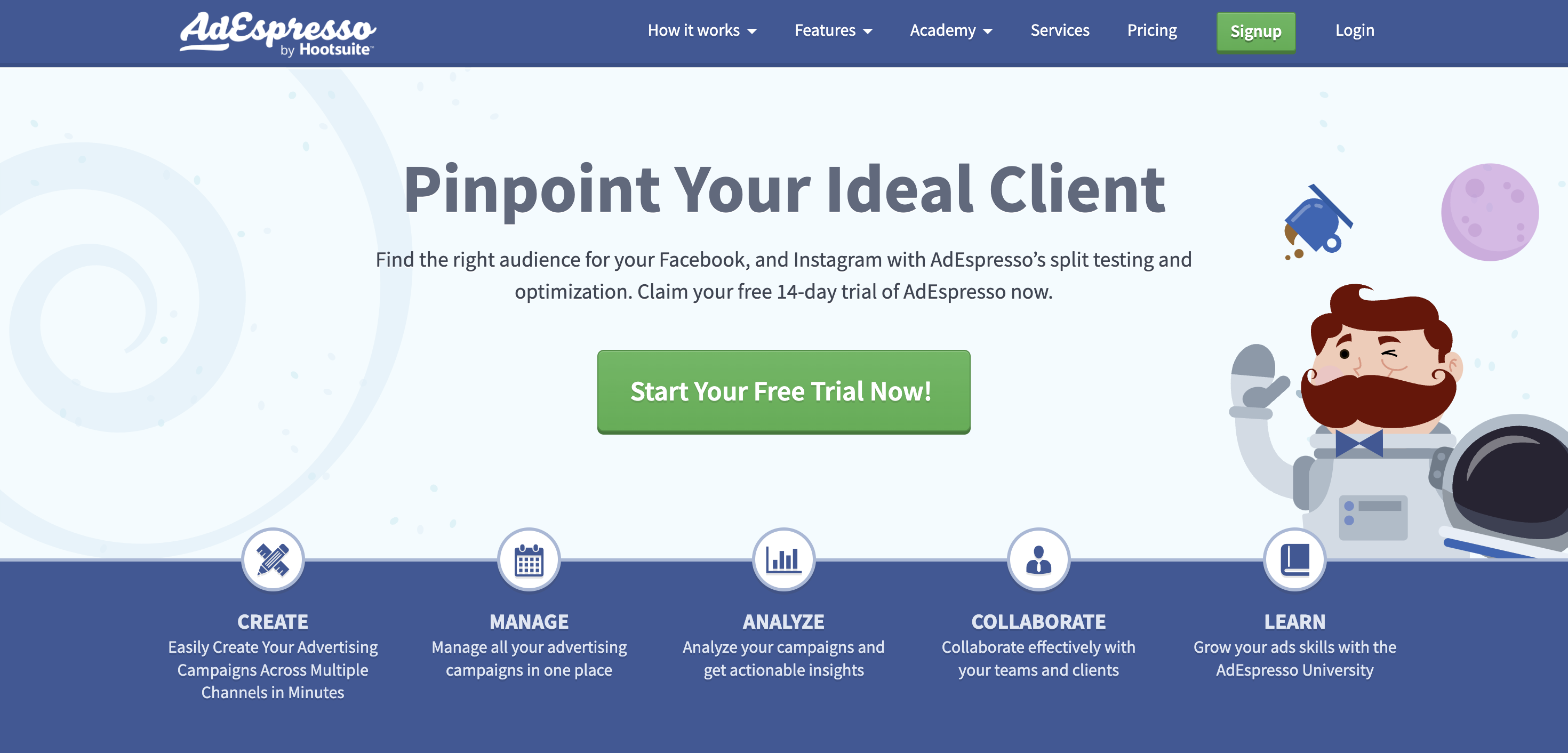
Source: AdEspresso
- WordStream. You can create ads, set up automation, and track your ad performance with this tool. It can be especially helpful if you find PPC management complicated.
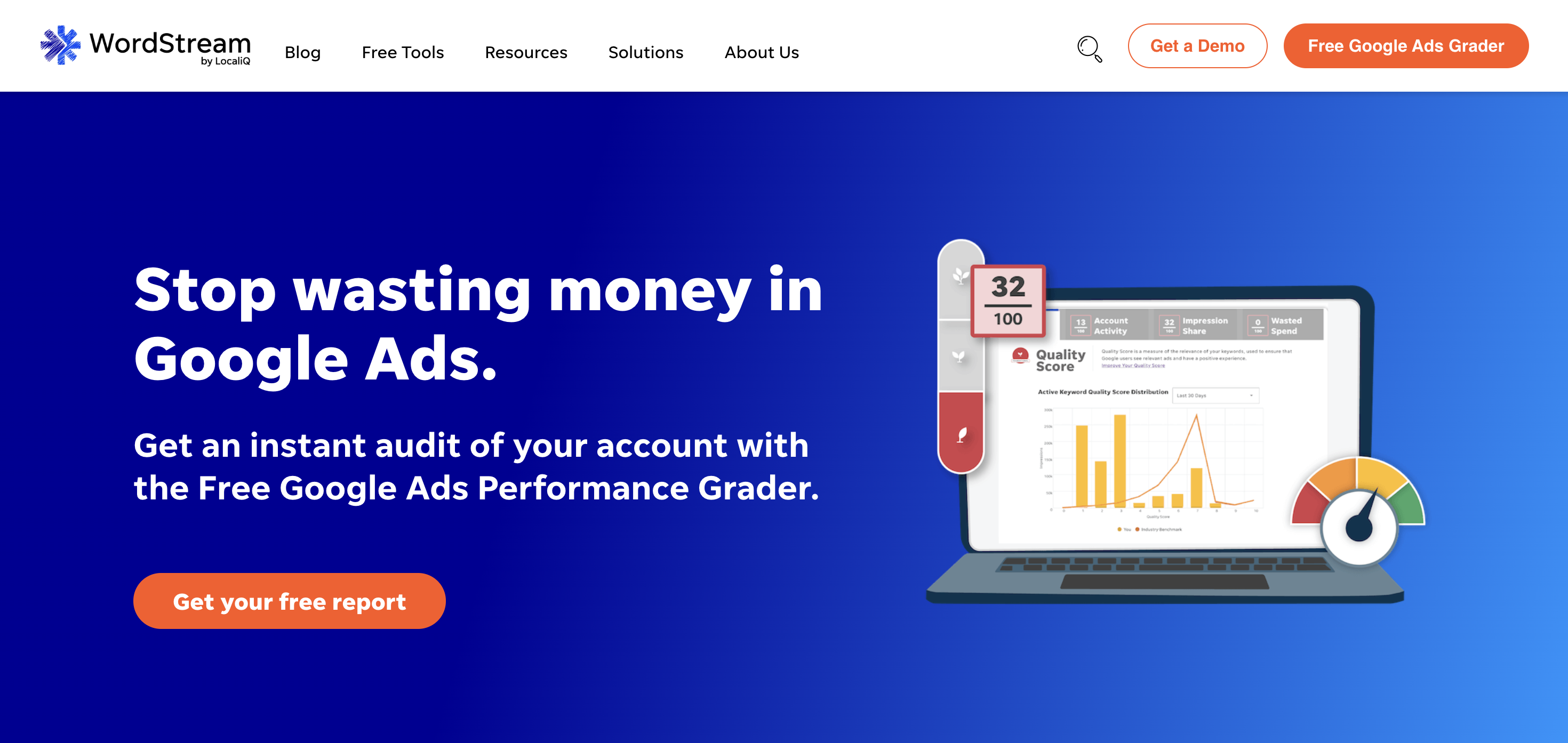
Source: WordStream
There are many good tools out there. The one you choose depends on your ad goals and budget. In the end, having good software by your side can improve your international paid search outcome.
Besides, the analytics data will come in handy for figuring out what works and what needs to be changed.
#7 Get the Help From an International PPC Agency (If It Makes Sense for You)
Here’s the truth – for most marketers and business owners, managing and creating winning ad campaigns is a lot of work. You will constantly need to find ways to balance things with running your business.
So, it only makes sense to get help from an international PPC agency if you feel like you are way in over your head and are drowning under all the load. You can also consider this option if:
- You don’t have the knowledge or skills to manage things yourself.
- You need help with regions outside your usual locations (new territories will take a while to fully master; in the meantime, agencies can handle the process for you).
- Have a tight deadline and way too much on your plate? Then, delegating this temporary to trusted multilingual PPC services isn’t such a bad idea.
Conclusion
If you have come this far, you already know more about PPC than most people out there.
Now, let’s recap: the answer to the question “how to run a PPC campaign” is pretty straightforward – it begins with knowing your target audience so you can put yourself in their shoes and better connect with them.
Next, you need powerful keywords, the right tools, a proper budget, a great copy, and an optimized landing page.
As long as you keep your eyes on the main goal, which is finding the best ways to create ads that people resonate with, you are well on your way to winning.
Enter URL & See What We Can Do Submit the form to get a detailed report, based on the comprehensive seo analysis.





